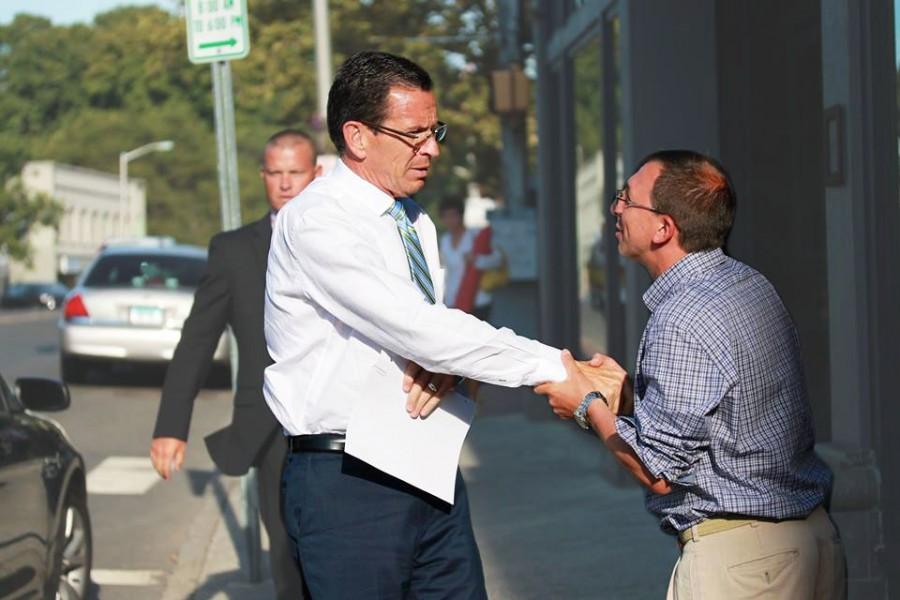CT officials debate tenure validity
On the fully-lit stage of the Norwich Free Academy auditorium, Democratic Governor Dannel P. Malloy and Republican opponent Tom Foley seemed at equal ends. Insults harangued, fingers pointed. It was a tennis-match of accusations and persecutions against the opponent.
However, the most powerful moment wasn’t an uncovered scandal or a simple gaffe. It was an apology.
“It was bad language,” Malloy said. “It wasn’t about them. It was about tenure.”
Malloy was referring to his now infamous statement four years ago, in which he said that teachers could receive tenure simply by showing up.
“I shouldn’t have said it. I apologize for saying it,” he said.
Tenure, by definition, guarantees that a teacher or professor will not be fired unless there is a justifiable cause. Recently, the question looming over the state’s school systems is if tenure will be restricted further or even outlawed in the Connecticut school systems.
In California, it was almost outlawed completely.
According to CNN, on June 10, 2014, California judge Rolf M. Treu ruled in favor of the law, arguing that firing bad teachers is nearly impossible due to tenure laws and union protections. He stated that this deprives students of the quality education they deserve. However, this reform was soon appealed due to the strong persistence of teacher unions.
This ruling would have made it much harder to “attract and retain quality teachers in our classrooms, and it ignores all research that shows experience is a key factor in effective teaching,” Dennis Van Roekel, the head of the National Education Association, said.
Teachers, like Staples science teacher William Jones, agreed that, in the Connecticut school systems, tenure is no shield from firing.
“In rare cases, it can be tough to get rid of an ineffective teacher,” Jones said. “But I think those cases are rare, and very over-represented in the news.”
The Connecticut General Assembly website stated, “Covered teachers first hired after July 1, 1996 attain tenure after working for 40 school months…,” making it one of the longest waiting-periods for tenure in any state in the country.
In fact, Staples principal John Dodig argued that tenure keeps qualified teachers from being fired based on bias.
“We’re all biased in some way,” he said. “If there were no tenure laws, and pay scale was becoming too expensive, I could just get rid of you.”
However some students, such as Nora Cowherd ’15 saw tenure as something that gave an unfair disadvantage to newer teachers.
“I don’t agree with this ‘last in, first out’ idea, that regardless of experience, the newest teachers are laid off first,” Cowherd said. “I think that the hardest working and best performing teachers should be allowed to keep their jobs.”
But as said by Jones, “I think some powerful people recognize a huge potential for schools to be monetized.” He went on to explain that without tenure, teachers would not be fired based upon their competence but based upon their profit.
Although Dodig claimed that the tenure system has always worked for the Staples administration, Malloy’s plan for educational reform is not for top-performing high schools like Staples, but for underperforming school districts.
According to a Connecticut State Department of Education review of schools for the 2011-2012 period, 83 schools were listed as not meeting satisfactory criteria, including six magnet schools. In addition, of the 55 schools listed with “Focus Areas” (schools where a specific group requires more attention due to struggle), 25 were designated with “Black” focus areas and 17 were designated with “Hispanic” focus areas.
However, even Dodig agreed the statistics have meaning.
“We don’t have an educational problem in America; we have a social problem,” he said. Dodig, who taught in the New Haven school system nearly four decades ago, recounts days where half of his students wouldn’t show up to class.
“It was a different half everyday. How could you hold me responsible?” he added. “It’s on the administration.”
Nonetheless, both sides have nothing but the students’ best interests in mind.
At the grand opening for the Westport Democratic Headquarters last Wednesday, Governor Malloy told guests of his administration’s continued support for educational improvement in Connecticut’s urban settings. His administration, he says, has built over 2,000 additional early childhood educational facilities in his three-and-a-half years of being governor.
“We are on the road to universal access to free kindergarten in places like Bridgeport,” Malloy said to cheers. “These are real improvements.”
Whether it be tenure restriction or government grants, Dodig assures that there is no definite answer to how the educational gap can be closed.
“If I had an answer, I would be the richest man in America,” Dodig said.
















































